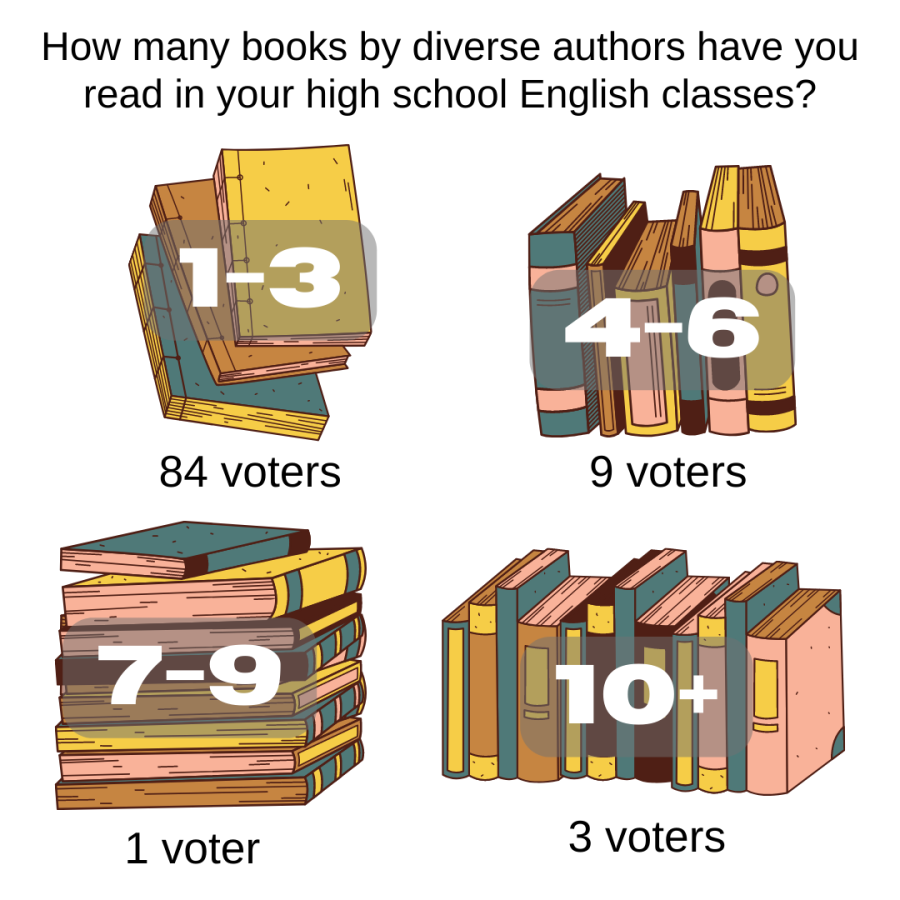English Literature curriculum isn’t diverse
January 31, 2022
Before the 20th century, literary work seldom included empowered female lead or a non-white lead character. But the continuous growth in the literature world has increased the number of novels centering on empowerment and awareness, from characters to authors.
But while the world evolves, the education system stays the same. Outdated, incorrect teaching continues, even if it isn’t as obvious as in the past.
The system has relied on white-dominant literature to teach students and shows no sign of changing. From Nathaniel Hawthorne to Ernest Hemingway to John Steinbeck, literature read in schools is predominately by white men. Rarely, a few women authors are included, such as Jane Austen – who is considered one of the greatest writers ever – or Mary Wollstonecraft Shelly.
A problem with white male authors is that they often don’t understand the perspective of the characters they write about – like Hawthorne with Hester Prynne. The Mentor Editorial believes that to provide students with more than one monotonous perspective, the English Literature curriculum should stop relying on the “classics” by such authors and instead start including novels – not short stories or quick articles – written by non-white and non-male authors.
Identifying standards that list required reading for high school students is difficult. Many non-school sources list books students should read before graduating, but few are written by women or non-white authors. Many of these novels are also recommended to students preparing for AP exams in English and Literature.
Using a more diverse selection benefits education greatly. There is a need for representation, discussion about serious topics, books about women written by women, books about Black men and women written by Black men and women.
The Kansas State Department of Education’s Standards for English Language Arts, as of 2017, lists the requirements for each grade level to attain in writing, speaking and listening, reading literature text and reading informational text. Nowhere in the standard does it state any requirements for novels, just standards that the novels need to help students achieve.
A common argument from educators is that they don’t have enough time to incorporate those novels.
But it’s not just about time, especially when teachers aren’t required to make students read a book written by a white man to meet a standard. They can use other books written by people who aren’t white or men that can easily meet the standards. It’s not adding to the lesson plan, it’s switching up the books used.
There is also the problem with the reliance on classics. The classics are named the way they are for a reason. These novels have been a staple in education and in literature since they were written. They provide historical events that give students an idea of what it was like during that period.
These novels have been read for generations. People justify the use of the novels with their overarching message or their literary value. But books only held up for so long because of the lack of education surrounding them and the reluctance to admit that they were not proper books for people to glorify.
There are plenty of classics that are written by non-white authors that hold up better than the others. “The Color Purple” by Alice Walker is considered one of the most important novels written. It tackles serious issues that people would rather keep under wraps. “Invisible Man” by Ralph Ellison discusses social and intellectual issues that Black men face. These two books can meet multiple requirements in the educational standard.
However, the curriculum can’t rely on classics, especially since there are hundreds of contemporary novels that can meet the standards, be relevant and hold up for a long period of time. “The Hate U Give” by Angie Thomas is a perfect example. The novel is one of the most loved and most impactful books to date. It can meet the requirement for 9-10 graders, “Analyze a particular point of view or cultural experience reflected in a work of literature.” Not only is the novel very accessible to students and teachers, but it also illustrates institutional racism and the broken criminal justice system from the perspective of a young Black girl.
Occasionally students do read literature from non-white authors, such as “The House on Mango Street” by Sandra Cisneros, a Latina woman, and various essays such as “Black Men in Public Spaces” by Brent Staples. But the English curriculum continues to primarily use books that are problematic or outdated and can easily be replaced. There is no justification for only picking novels that are by white men. It’s not a time issue, it’s not a lack of access issue. It’s a lack of collaboration and action to include novels written by non-white authors.
The limited perspectives negatively alter the students’ ideas and realities. When students are only fed stories from the perspective of a white man, they will have an altered view of reality, one that is false and not beneficial. Students deserve to not only read and analyze books that have different perspectives but also deserve to be represented in literature.


